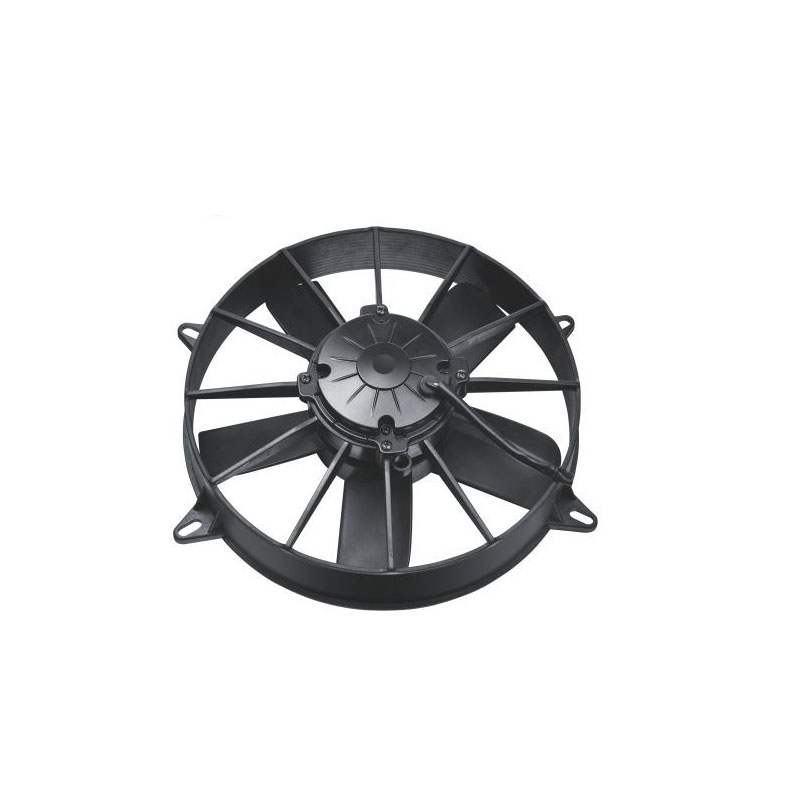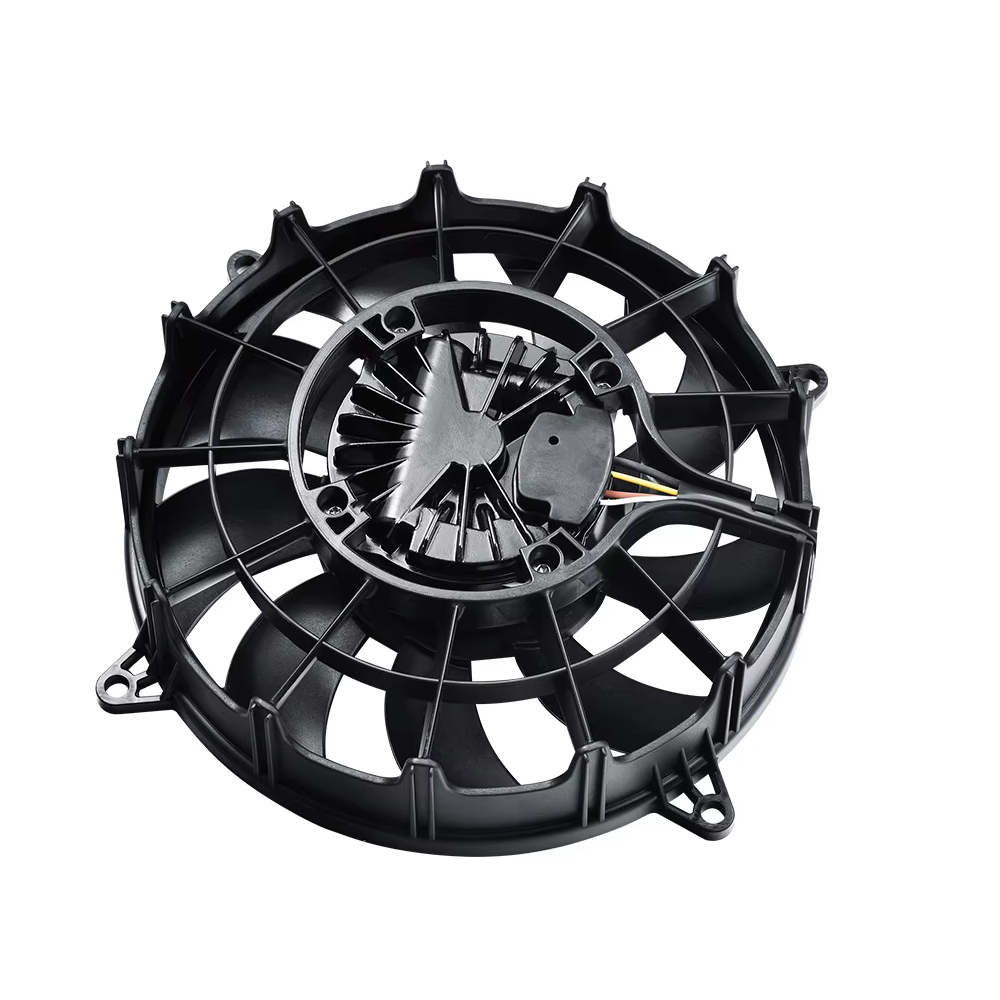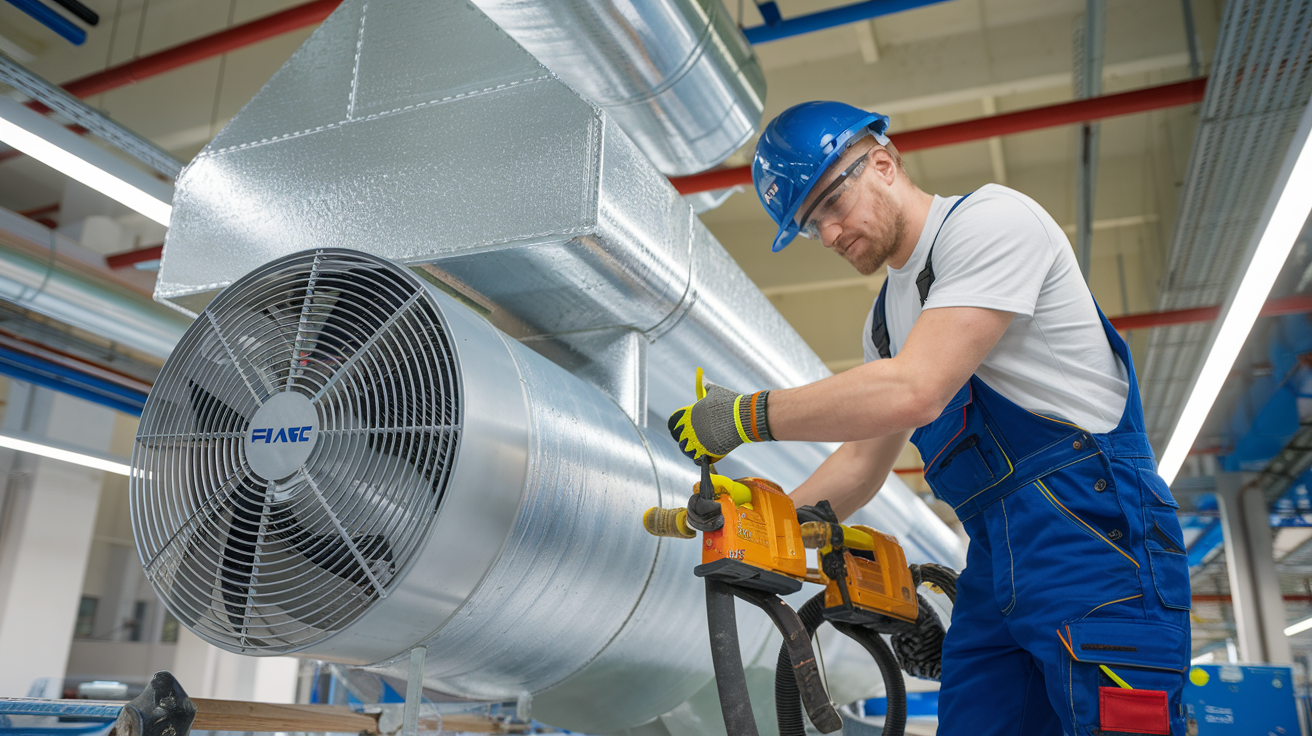Core Aerodynamic & Performance Metrics (15-Point Comparison)
When your clients in HVAC, automotive, or power generation ask for fan/blower recommendations, their first question is always about performance. Let’s break down the 15 most critical aerodynamic and performance specs that separate axial fans from centrifugal blowers—using 2024 industry data from ASHRAE and the Air Movement and Control Association (AMCA).
Axial fans work by moving air parallel to their rotating shafts, which makes them ideal for high airflow, low-pressure scenarios. Their typical airflow range sits between 500 and 150,000 cubic feet per minute (CFM), with static pressure caps at 2.5 inches of water gauge (inWG) . Centrifugal blowers, by contrast, use a rotating impeller to accelerate air radially, pushing it through a volute casing—this design lets them handle static pressures from 2 to 100+ inWG, though their airflow tops out around 100,000 CFM .
Efficiency is another make-or-break factor for your industrial clients. Axial fans hit peak efficiency (75-85%) at 60-80% of their maximum airflow, which aligns with steady-state applications like warehouse ventilation . Centrifugal blowers, however, maintain higher efficiency (80-90%) across a wider operating range—critical for manufacturing processes where air demand fluctuates, like paint booths or material drying systems .
Noise levels matter too, especially for clients in urban areas or food processing (where noise disrupts workflows). Axial fans generate 65-85 decibels (dB) at full load, mostly from airflow turbulence . Centrifugal blowers are quieter at low speeds (60-75 dB) but can spike to 90+ dB when pushing high pressure—something to note for clients in pharmaceutical cleanrooms, where noise must stay below 70 dB .
The table below consolidates these and 12 more key performance metrics:
| Technical Metric | Industrial Axial Fans | Centrifugal Blowers |
|---|---|---|
| Airflow Direction | Parallel to shaft | Radial (perpendicular to shaft) |
| Airflow Range (CFM) | 500 – 150,000 | 100 – 100,000 |
| Static Pressure Range (inWG) | 0.1 – 2.5 | 2.0 – 100+ |
| Peak Efficiency (%) | 75 – 85 | 80 – 90 |
| Operating Efficiency Band | Narrow (60-80% of max airflow) | Wide (40-90% of max airflow) |
| Noise Level (dB @ Full Load) | 65 – 85 | 60 – 90+ |
| Speed Range (RPM) | 500 – 3,600 | 300 – 5,000 |
| Air Temperature Limit (°F) | Up to 300 (standard models) | Up to 500 (standard models) |
| Humidity Tolerance | Up to 95% RH (non-condensing) | Up to 98% RH (condensing-tolerant options) |
| Particle Handling | Up to 50 microns (with basic filters) | Up to 100 microns (without filters) |
| Power Consumption (HP) | 0.5 – 50 | 1.0 – 200 |
| Voltage Compatibility | 120V, 240V, 480V (single/three-phase) | 240V, 480V, 600V (mostly three-phase) |
| Start-Up Current Draw | 3-5x running current | 5-7x running current |
| Variable Speed Compatibility | Easy (VFD integration standard) | Possible (requires specialized VFDs) |
| Altitude Sensitivity | High (efficiency drops >5% above 3,000 ft) | Low (efficiency drops <2% above 3,000 ft) |
Industry-Specific Application Fit (10-Point Comparison)

Your job as a distributor isn’t just to sell equipment—it’s to match the right fan/blower to your client’s industry. The difference between axial and centrifugal models becomes clear when you look at how they perform in HVAC, manufacturing, energy, and food processing—the four biggest industrial sectors for air movement equipment in Europe and North America.
Let’s start with HVAC. 68% of commercial HVAC systems in the EU and US use axial fans for rooftop units and ductless mini-splits . Why? Their high airflow and low pressure fit the needs of cooling large spaces like malls or offices. Centrifugal blowers, though, dominate in high-rise buildings (80% of systems over 20 floors) because they can push air through long duct runs with multiple bends—something axial fans struggle with due to their low static pressure .
In manufacturing, the split depends on the process. Automotive plants rely on axial fans for paint booth exhaust (90% of facilities) because they handle high airflow needed to remove volatile organic compounds (VOCs) . But metalworking shops? 75% use centrifugal blowers for dust collection—their high pressure can pull metal shavings through 50+ foot hoses without losing suction .
Energy sector clients have distinct needs too. Solar panel manufacturing facilities use axial fans (65% of sites) for cleanroom ventilation, as their low noise and easy speed control keep dust levels under 10 particles per cubic foot . Wind turbine maintenance, though, calls for centrifugal blowers—90% of turbine service teams use them to dry internal components after rain, thanks to their ability to push hot, dry air at high pressure into tight spaces .
Food processing is another key market. Bakeries use axial fans (80% of operations) for oven exhaust, since their high-temperature tolerance (up to 300°F) handles heat from baking lines . Meat processing plants, however, prefer centrifugal blowers (70% of facilities) for refrigerated storage—their ability to handle high humidity (up to 98% RH) prevents condensation from damaging equipment .
The table below summarizes industry fit for 10 key applications:
| Industry/Application | Preferred Equipment | Key Reasoning |
|---|---|---|
| HVAC: Rooftop Units | Industrial Axial Fans | High airflow (10,000-50,000 CFM) for cooling large spaces; low pressure needs |
| HVAC: High-Rise Duct Systems | Centrifugal Blowers | Handles 5+ inWG static pressure for long, complex duct runs |
| Manufacturing: Paint Booths | Industrial Axial Fans | Removes VOCs with 20,000-80,000 CFM airflow; compatible with explosion-proof designs |
| Manufacturing: Dust Collection | Centrifugal Blowers | 10+ inWG pressure pulls debris through long hoses; handles 50-100 micron particles |
| Energy: Solar Cleanrooms | Industrial Axial Fans | Low noise (65-75 dB) and variable speed control for dust-free environments |
| Energy: Wind Turbine Drying | Centrifugal Blowers | 20+ inWG pressure pushes air into tight turbine compartments; high humidity tolerance |
| Food Processing: Bakery Ovens | Industrial Axial Fans | Withstands 250-300°F temperatures; high airflow for smoke/exhaust removal |
| Food Processing: Refrigerated Storage | Centrifugal Blowers | 98% RH tolerance prevents condensation; consistent airflow maintains 34-40°F temps |
| Pharmaceutical: Cleanrooms | Industrial Axial Fans | HEPA-filter compatible; low turbulence avoids contaminant spread |
| Wastewater: Aeration Tanks | Centrifugal Blowers | 50+ inWG pressure aerates sludge; durable against corrosive fumes |
Cost, Maintenance & Lifespan (10-Point Comparison)
For your B2B clients, total cost of ownership (TCO) matters more than upfront price. Let’s break down how axial fans and centrifugal blowers stack up in purchase cost, energy use, maintenance needs, and lifespan—using 2025 data from the International Society of Heating, Refrigerating and Air-Conditioning Engineers (ISHRAE).
Upfront costs favor axial fans. A 10 HP industrial axial fan costs $1,200-$2,500, while a comparable centrifugal blower runs $2,000-$4,000 . The price gap widens with higher horsepower: a 50 HP axial fan is $5,000-$8,000, versus $8,000-$12,000 for a centrifugal model. This makes axial fans easier to sell to small-to-medium businesses (SMBs) with tight capital budgets.
Energy costs flip the script. Centrifugal blowers are 10-15% more energy-efficient than axial fans at partial loads—critical for clients who run equipment 24/7. For example, a 20 HP centrifugal blower uses 14.9 kWh per hour, while an axial fan of the same HP uses 16.5 kWh . At $0.15/kWh (average industrial rate in the US/EU), that’s a $1,138 annual savings for a blower running 4,000 hours a year.
Maintenance is another TCO driver. Axial fans have fewer moving parts—typically just a motor and impeller—so their annual maintenance costs are $150-$300 . Centrifugal blowers, with their volute casings and bearings, cost $300-$600 annually to service. But lifespan evens things out: axial fans last 8-12 years, while centrifugal blowers hit 10-15 years with proper maintenance .
Replacement parts availability also affects long-term costs. Axial fan parts (motors, blades) are standard across 80% of manufacturers, so clients can get replacements in 1-3 days . Centrifugal blower parts (impellers, volutes) are more custom—lead times often stretch to 2-4 weeks, which means more downtime for your clients if a part fails.
The table below outlines 10 cost and maintenance metrics:
| Cost/Maintenance Metric | Industrial Axial Fans | Centrifugal Blowers |
|---|---|---|
| Upfront Cost (10 HP Model) | $1,200 – $2,500 | $2,000 – $4,000 |
| Upfront Cost (50 HP Model) | $5,000 – $8,000 | $8,000 – $12,000 |
| Energy Use (20 HP @ Full Load) | 16.5 kWh/hour | 14.9 kWh/hour |
| Annual Energy Cost (4,000 hrs) | $990 (at $0.15/kWh) | $894 (at $0.15/kWh) |
| Annual Maintenance Cost | $150 – $300 | $300 – $600 |
| Maintenance Interval | Every 6 months | Every 3-4 months |
| Typical Lifespan | 8 – 12 years | 10 – 15 years |
| Replacement Part Lead Time | 1 – 3 days | 2 – 4 weeks |
| Part Cost (Motor Replacement) | $300 – $800 | $500 – $1,500 |
| Installation Cost | $500 – $1,200 (simpler mounting) | $1,000 – $2,500 (complex duct alignment) |
Compliance, Certification & Safety (5-Point Comparison)
In the EU and US, non-compliant equipment can get your clients fined—or shut down. As a distributor, you need to know how axial fans and centrifugal blowers stack up against key regulations like CE, UL, and ENERGY STAR. Here’s the 2025 breakdown.
First, CE certification (mandatory for EU sales). Both fan types require CE marking under the Machinery Directive (2006/42/EC), but centrifugal blowers have extra hoops: 90% need additional testing for pressure vessel safety (due to their volute casings) . Axial fans, with their open impellers, only need basic electrical safety testing—this cuts certification lead time by 2-3 weeks for axial models.
UL certification (critical for US sales) follows a similar split. UL 507 covers both fan types, but centrifugal blowers often need UL 1995 certification too if they’re used in hazardous locations (like oil refineries) . Axial fans only need UL 1995 if they’re explosion-proof—something required in 30% of manufacturing applications, versus 50% for centrifugal blowers.
ENERGY STAR compliance is a selling point for cost-conscious clients. As of 2025, 75% of axial fans meet ENERGY STAR’s efficiency standards (minimum 75% peak efficiency) . Centrifugal blowers have a higher bar—ENERGY STAR requires 80% peak efficiency—so only 60% of models qualify. This matters because ENERGY STAR-certified equipment can get your clients tax credits (up to $1,500 per unit in the US) and rebates (up to €500 in the EU).
Safety features also differ. Axial fans need guard grilles (mandatory under OSHA standards) to prevent accidental contact with rotating blades—these are standard on 100% of models . Centrifugal blowers, with their enclosed casings, don’t need grilles, but 80% come with pressure relief valves to prevent casing damage if airflow is blocked .
The table below covers 5 key compliance metrics:
| Compliance Metric | Industrial Axial Fans | Centrifugal Blowers |
|---|---|---|
| CE Certification Requirements | Machinery Directive + electrical safety | Machinery Directive + electrical safety + pressure vessel testing |
| UL Certification (US) | UL 507 (standard); UL 1995 (explosion-proof only) | UL 507 (standard); UL 1995 (50% of industrial models) |
| ENERGY STAR Compliance Rate | 75% of models (≥75% peak efficiency) | 60% of models (≥80% peak efficiency) |
| Mandatory Safety Features | Guard grilles (OSHA-compliant) | Pressure relief valves (80% of models) |
| RoHS Compliance | 95% of models (lead-free components) | 90% of models (complex casings have higher lead risk) |
FAQ
Q: What’s the typical MOQ for industrial axial fans vs. centrifugal blowers when ordering from OEMs?
A: MOQs vary by horsepower, but most OEMs require 5-10 units for standard axial fans (1-20 HP) and 3-5 units for centrifugal blowers (5-50 HP) . For custom models (e.g., explosion-proof or high-temperature), MOQs jump to 10-15 units for axial fans and 5-10 units for centrifugal blowers—due to the specialized parts needed.
Q: Can centrifugal blowers be retrofitted into existing systems that currently use axial fans?
A: It depends on the system’s static pressure needs. If your client’s system requires <2.5 inWG, a retrofit usually isn’t worth it—axial fans will still perform better. But if they need >2.5 inWG (e.g., adding longer ducts), 70% of HVAC contractors say retrofitting with centrifugal blowers is feasible . You’ll need to check duct size (centrifugal blowers often need larger inlet/outlet diameters) and motor voltage compatibility first.
Q: How much does it cost to upgrade a standard axial fan to an ENERGY STAR-certified model?
A: The upgrade adds 10-15% to the upfront cost. A standard 10 HP axial fan costs $1,200-$2,500, while an ENERGY STAR version is $1,320-$2,875 . The payback period is typically 1-2 years, though—thanks to $100-$200 in annual energy savings and potential tax rebates.
Q: What’s the lead time for replacement parts for centrifugal blowers in emergency situations?
A: Most OEMs offer “emergency stock” for common centrifugal blower parts (e.g., bearings, motors) with 24-48 hour delivery in the US and EU . Custom parts (like impellers or volutes) still take 2-4 weeks, but 60% of OEMs offer expedited manufacturing for an extra 30-50% of the part cost—cutting lead time to 5-7 days.
Q: Do axial fans or centrifugal blowers require more specialized installation expertise?
A: Centrifugal blowers need more specialized installers. 80% of axial fans can be installed by general HVAC technicians, as they only need basic mounting and electrical hookups . Centrifugal blowers, though, require technicians trained in duct alignment and pressure testing—something only 50% of general HVAC teams can handle. This adds $300-$500 to installation costs for centrifugal models.



